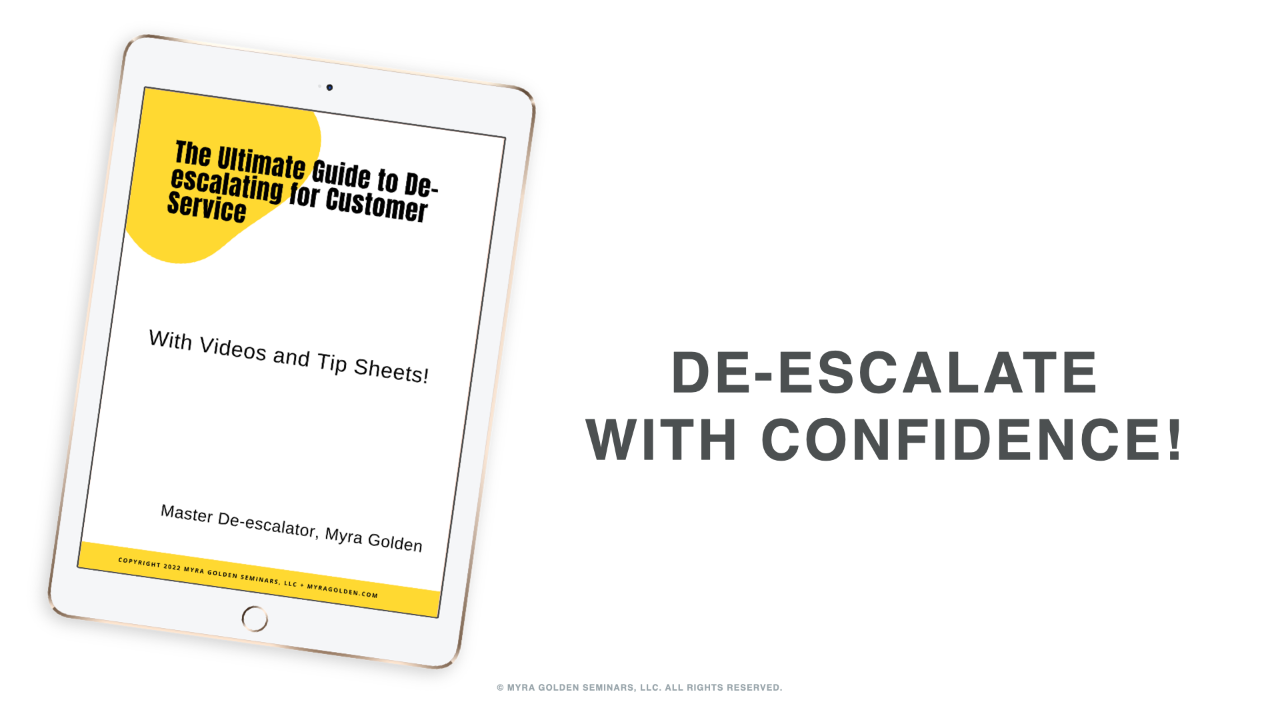A Guide to De-escalating Difficult Customers: Tips and Techniques for Success

As a former Kmart associate and call center manager, I have encountered my fair share of difficult customers. From angry phone calls to in-person interactions, it can be challenging to de-escalate a situation and provide a positive customer experience. However, it is crucial to understand the importance of de-escalating difficult customers and how it can benefit both the customer and the company. In this Ultimate Guide to De-escalating Difficult Customers, I share tips and techniques for successfully de-escalating difficult customers. And...I've included videos and a tip sheet!
Understanding Why Customers Become Difficult
Before we dive into de-escalation techniques, it is essential to understand why customers become difficult in the first place. Customers may become difficult due to various reasons, including frustration with a product or service, feeling undervalued or unheard, or experiencing a personal issue that affects their behavior. It is also important to note that some customers may have a complex personality or be having a bad day.
As customer service representatives, we must remain calm and professional, regardless of the customer's behavior. Understanding why a customer behaves a certain way can help us approach the situation empathetically and find a solution that meets their needs.
I recorded this video in my Tulsa studio to help contact center representatives understand the psychology about why customers become so difficult.
The Importance of De-escalating Difficult Customers
De-escalating a difficult customer is crucial for both the customer and the company. A customer who feels heard and valued is more likely to continue doing business with the company and may even become a loyal customer. On the other hand, a customer who feels ignored or mistreated may leave a negative review or stop doing business with the company altogether.
Additionally, de-escalating a difficult customer can improve the customer service representative's job satisfaction and reduce workplace stress. It is important to remember that customer service representatives are constantly talking to challenging customers, and dealing with difficult customers can be emotionally taxing.
Common Mistakes to Avoid When De-escalating Customers
When de-escalating a difficult customer, several common mistakes should be avoided. One mistake is becoming defensive or argumentative with the customer. This can escalate the situation and make the customer feel unheard. Additionally, it is important to refrain from making promises that cannot be kept, as this can lead to further frustration for the customer.
Another common mistake is failing to listen actively to the customer. Allowing the customer to express their concerns and validate their feelings is crucial. Ignoring the customer's concerns or interrupting them can make the situation worse.
A mistake I often hear is telling a customer they are wrong. Heck yeah, customers make mistakes- a lot! But when you tell a customer they are wrong, you're starting the cycle of escalation. Dale Carnegie, the author of How to Win Friends and Influence People, breaks down what happens when you tell someone they're wrong. "Telling someone they're wrong is a direct blow at their intelligence, pride, and self-respect. It doesn't make them want to agree with you but strike back. If you are going to prove anything, try not to let anyone know about it. Do it subtly and adroitly so no one knows you're doing it." Yep, Carnegie nailed it!
You can still make your point to a customer without outright saying you're wrong. Let's say your customer thinks they have your two-year warranty, yet you see in their account they do not. Rather than explaining, "Sir, you did not take out the Platinum Tier protection plan," Try instead, "Let's look at your account and see what options we have." At this point, you can discuss the customer's options, then politely explain, "We do have a fantastic two-year Plantimun protection plan, yet it looks like you didn't select that option at the time of purchase."
3 Steps to De-escalating a Difficult Customer
When de-escalating a difficult customer, three easy steps can be taken to ensure a positive outcome.
Step One: The first step in de-escalation is Recognizing the customer's concern. When you acknowledge the customer's pain point and show empathy for their experience, you'll often preempt escalation and move the person from the right emotional brain to a focus on resolving the issue.
Here's how to recognize your customer's concern:
"I can see your point on that."
"I want to get to the bottom of this as much as you do."
"I understand and will do everything in my power to get this resolved immediately."
"I realize the situation this puts you in, and I am sorry."
Step Two: The second step in de-escalating customers is Reframe. Reframing is to take the focus off of the problem through positive positioning. Sometimes difficult customers will vent, making themselves more upset, and making it harder for you to cut to the business of fixing the issue. So try these reframing statements to help customers move on.
"We want to get to the bottom of this as much as you do."
"I certainly understand your concern. Let's take a look and see what's going on."
"While the warranty doesn't cover this, we do have a couple of options for you today.."
Reframing statements are fantastic for getting customers past excessive venting about the problem.
One of my favorite way to reframe is by making three statements:
Here's what we know.
Here's what we've done.
Here's what's next.
I walk through these three powerful steps to de-escalating with customers through reframing this video.
Learn about my De-escalation Training for Customer Service Professionals!
Step Three: The final step in de-escalating with customers is Resolve. Resolution guides the customer to the next steps, re-presenting options, or containing the situation.
Step 3, Resolve in Action
One of my clients is a water utility. One of their most challenging customer interactions is telling customers that to have water services connected; they must pay the debt left by the previous tenant or owner! Customers understandably would be upset, and many would demand a manager. This problem is something other than what my client's contact center agents had the power to solve. They couldn't waive the balance or force the previous tenant or landlord to cover the debt.
So, in this situation, resolving the problem is guiding the customer to the next steps. Here's the resolution I wrote to help the customer service representatives de-escalate by driving the customer to the next steps:
"As a solution, I have two suggestions. First, you need to talk to your landlord. Tell them there's a debt on the meter and that you can't turn on the water. See if they'll work something out for you. The second option, and I'd do this immediately, is to look carefully at your lease to see if any clause protects you in this situation."
Active Listening Techniques for De-escalation
Active listening is a crucial component of de-escalating a difficult customer. To actively listen, it is important to give the customer your undivided attention and avoid interrupting them. Additionally, it can be helpful to paraphrase the customer's concerns to ensure that they feel heard and understood.
Body language can also play a role in active listening. Maintaining eye contact and nodding to show understanding can help the customer feel heard and valued.
Empathy and its Role in De-escalation
Empathy is another essential component of de-escalating a difficult customer. When a customer feels heard and understood, they are more likely to be receptive to finding a solution. Expressing empathy can be done by acknowledging the customer's frustration and expressing understanding for their situation.
It is important to remember that empathy does not mean agreeing with the customer's behavior or demands. Instead, it is about understanding their perspective and finding a solution that meets their needs while also aligning with the company's policies.
Get my 20 Damn-Good Empathy Phrases Tip Sheet!
Using Positive Language to Diffuse Tense Situations
Using positive language can help diffuse tense situations and create a more positive customer experience. This can be done by avoiding negative language or blame and focusing on finding a solution.
For example, instead of saying, "I can't do that," try saying, "Let me see what I can do to help." This approach focuses on finding a solution while also acknowledging the customer's concerns.
De-escalation Techniques for Phone Calls
De-escalating a difficult customer over the phone requires a different approach than in-person interactions. It is important to remain calm and professional, even if the customer becomes angry or upset. Additionally, active listening and empathy are crucial components of de-escalating a phone call.
Another technique for de-escalating a phone call is to speak slowly and clearly. This can help the customer feel heard and understood and reduce misunderstandings.
De-escalation Techniques for in-person Interactions
De-escalating a difficult customer in-person requires a different approach than over the phone. It is important to maintain a calm and professional demeanor and avoid becoming defensive or argumentative.
Active listening and empathy are also essential components of de-escalating an in-person interaction. Additionally, it can be helpful to maintain a neutral tone of voice and avoid using negative language or blame.
Handling Difficult Customers in a Team Environment
Handling difficult customers in a team environment requires clear communication and a unified approach. It is important to establish clear policies and procedures for de-escalating difficult customers and ensure that all team members are trained in these techniques.
Additionally, it can be helpful to have a designated team member who is responsible for handling difficult customers. This can ensure consistency in approach and provide a point person for customers to reach out to.
Training Resources for De-escalation Techniques
One of the best ways to prepare employees to confidently and assertively de-escalate is to send them to De-escalation Academy. De-escalation Academy is the only training for customer service that not only shows your employees how to redirect verbal aggression and regain control of interactions - but how to get customers to accept their words as final.
In my De-escalation Training, your employees go from feeling overwhelmed and powerless when they have to give customers bad news, to feeling confident, firm, and in-control as they bring down the temperature in interactions and guide customers to next steps.
Learn more about De-escalation Academy in this 1-minute video.
Enroll Your Team in De-escalation Academy!
Conclusion
De-escalating difficult customers is an essential component of providing a positive customer experience. By understanding why customers become difficult, avoiding common mistakes, and using active listening, empathy, and positive language, customer service representatives can successfully de-escalate tense situations.
Whether handling difficult customers over the phone or in-person, remaining calm and professional and offering solutions that meet the customer's needs can create a more positive outcome for both the customer and the company.
Remember, training resources, like my free YouTube videos and my behavior-transforming De-escalation Academy, are available for customer service representatives who want to improve their de-escalation skills, and ongoing support and training can help ensure success in handling difficult customers.
De-escalation Academy
The step-by-step, psychology-backed system that helps your team handle any tough customer interaction with calm, control, and confidence—on the phone, in person, or in chat.
Join Myra’s Inner Circle: Insights, Strategies, and Resources for Leaders Who Demand the Best.
Be the first to receive exclusive strategies, curated resources, and behind-the-scenes insights from Myra Golden—crafted for leaders who value excellence.
Your information will remain private and protected—always.

